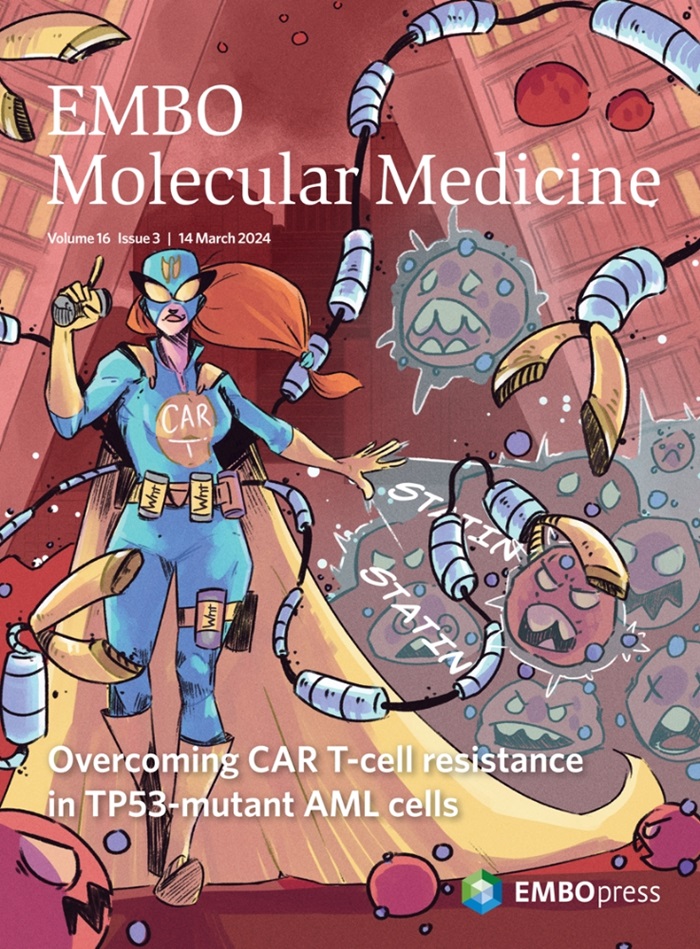Glia inflammation and cell death pathways drive disease progression in preclinical and early AD.
IF 8.3
1区 医学
Q1 MEDICINE, RESEARCH & EXPERIMENTAL
引用次数: 0
Abstract
Accumulation of amyloid-β (Aβ) and neurofibrillary tangles (NFTs) are followed by the activation of glia cells and infiltration of peripheral immune cells that collectively accelerate neurodegeneration in preclinical AD models. Yet, the role of neuroinflammation for neuronal injury and disease progression in preclinical and early symptomatic AD remains elusive. Here, we combined multiplexed immunoassays and SomaScan proteomics of the cerebrospinal fluid (CSF) with MRI and PET brain imaging of people across the AD continuum to identify pathways that are associated with AD progression. Unbiased clustering revealed that glia-mediated inflammation, activation of cell death pathways (CDPs) and synaptic pathologies were among the earliest Aβ-induced changes, and were associated with disease progression in preclinical AD. Mediation analysis revealed that activation of CDPs were decisive drivers of inflammation in early symptomatic AD. The cycle of glia-mediated neuroinflammation and neuronal injury characterizes preclinical AD and has implications for novel treatment approaches.神经胶质炎症和细胞死亡途径驱动临床前和早期AD的疾病进展。
淀粉样蛋白-β (Aβ)和神经原纤维缠结(nft)的积累随后是胶质细胞的激活和外周免疫细胞的浸润,这些共同加速了临床前AD模型中的神经变性。然而,在临床前和早期症状性阿尔茨海默病中,神经炎症在神经元损伤和疾病进展中的作用仍然难以捉摸。在这里,我们将脑脊液(CSF)的多重免疫测定和SomaScan蛋白质组学与AD连续体患者的MRI和PET脑成像相结合,以确定与AD进展相关的途径。无偏聚类显示,神经胶质介导的炎症、细胞死亡通路(CDPs)的激活和突触病理是a β诱导的最早的变化,并且与临床前AD的疾病进展有关。中介分析显示,CDPs的激活是早期症状性AD炎症的决定性驱动因素。神经胶质介导的神经炎症和神经元损伤的循环是临床前AD的特征,并对新的治疗方法具有重要意义。
本文章由计算机程序翻译,如有差异,请以英文原文为准。
求助全文
约1分钟内获得全文
求助全文
来源期刊

EMBO Molecular Medicine
医学-医学:研究与实验
CiteScore
17.70
自引率
0.90%
发文量
105
审稿时长
4-8 weeks
期刊介绍:
EMBO Molecular Medicine is an open access journal in the field of experimental medicine, dedicated to science at the interface between clinical research and basic life sciences. In addition to human data, we welcome original studies performed in cells and/or animals provided they demonstrate human disease relevance.
To enhance and better specify our commitment to precision medicine, we have expanded the scope of EMM and call for contributions in the following fields:
Environmental health and medicine, in particular studies in the field of environmental medicine in its functional and mechanistic aspects (exposome studies, toxicology, biomarkers, modeling, and intervention).
Clinical studies and case reports - Human clinical studies providing decisive clues how to control a given disease (epidemiological, pathophysiological, therapeutic, and vaccine studies). Case reports supporting hypothesis-driven research on the disease.
Biomedical technologies - Studies that present innovative materials, tools, devices, and technologies with direct translational potential and applicability (imaging technologies, drug delivery systems, tissue engineering, and AI)
 求助内容:
求助内容: 应助结果提醒方式:
应助结果提醒方式:


